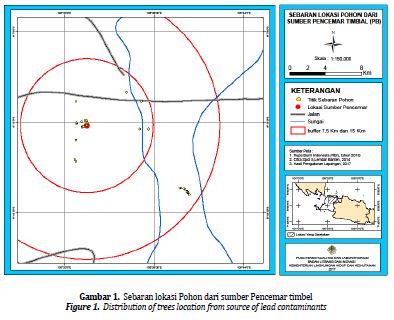Konsentrasi timbel (Pb) pada daun dari beberapa jenis pohon di sekitar kawasan industri Kadu Manis, Tangerang

Downloads
Downloads
Ai, N. S. (2011). Biomassa dan kandungan klorofil total daun jahe (Zingiber officinale L.) yang mengalami cekaman kekeringan. Jurnal Ilmiah Sains, 11(1), 1–5.
Alifandi, A. (2010). Menghapus bensin bertimbal di Indonesia -BBC Indonesia. Retrieved January 19, 2018, from http://www.bbc.com/indonesia/laporan_khusus/2010/03/100325_bensintimbal
Arisusanti, R. J., & Purwani, K. I. (2013). Pengaruh mikoriza Glomus fasciculatum terhadap akumulasi logam timbal (Pb) pada tanaman Dahlia pinnata. Sains Dan Seni Poits, 2(2), 69–73.
Bermudez, G. M. A., Moreno, M., Invernizzi, R., Pla , R., & Pignata, M. L. (2010). Heavy metal pollution in topsoils near a cement plant: The role of organic matter and distance to the source to predict total and HCl-extracted heavy metal concentrations. Journal of Chemosphere, 78(4), 375–381. https://doi.org/10.1016/j.chemosphere.2009.11.012
Caroline, J., & Moa, G. A. (2015). Fitoremediasi logam timbal (Pb) menggunakan tanaman melati air (Echinodorus palaefolius) pada limbah industri peleburan tembaga dan kuningan. In Seminar Nasional Sains dan Teknologi Terapan III 2015 (pp. 733–744). Surabaya: Institut Teknologi Adhi Tama Surabaya.
Chrastny , V., Vane k, A., Teper, L., Cabala, J., Procha zka, J., Pechar, L., … Nova k, M. (2012). Geochemical position of Pb, Zn and Cd in soils near the Olkusz mine/smelter, South Poland: effects of land use, type of contamination and distance from pollution source. Journal of Environmental Monitoring and Assessment, 184(4), 2517–2536. https://doi.org/10.1007/s10661-011-2135-2
Departemen Pekerjaan Umum. Pedoman Penyediaan dan Pemanfaatan Ruang Terbuka Hijau di Kawasan Perkotaan, Pub. L. No. 05/PRT/M/2008 (2008). Indonesia.
Dewi, Y. S. (2012). Kajian efektifitas Daun Puring (Codiaeum Variegatum) dan Lidah Mertua (Sansevieria trispasciata) dalam menyerap timbal di udara ambien. Jurnal Ilmiah Universitas Satya Negara Indonesia, Vol.5(Desember), 1–7.
Gujarati, D. N., & Porter, D. C. (2004). Basic econometrics -Economic series McGraw-Hill international editions: Economic series. The McGraw Hill Companies. https://doi.org/10.2307/2344828
Gulia, S., Shiva Nagendra, S. M., Khare, M., & Khanna, I. (2015). Urban air quality management-a review. Journal of Atmospheric Pollution Research, 6(2), 286–304. https://doi.org/10.5094/APR.2015.033
Haryati, M., Purnomo, T., & Kuntjoro, S. (2012). Kemampuan tanaman genjer (Limnocharis flava (L.) Buch.) menyerap logam berat timbal (Pb) limbah cair kertas pada biomassa dan waktu pemaparan yang berbeda. Jurnal Lentera Bio, 1(3), 131–138.
Hendrasarie, N. (2007). Kajian efektifitas tanaman dalam menjerap kandungan Pb di udara. Jurnal Rekayasa Perencanaan, 3(2), 1–15.
Hermawan, R., Kusmana, C., Nasrullah, N., & Prasetyo, L. B. (2011). Jerapan debu dan partikel timbal (pb) oleh daun berdasarkan letak pohon dan posisi tajuk: studi kasus jalur hijau Acacia mangium, jalan Tol Jagorawi. Media Konservasi, 16(3), 101–107.
Inayah, S. N., Las, T., & Yunita, E. (2010). Kandungan Pb pada daun Angsana (Pterocarpus indicus) dan Rumput Gajah Mini (Axonopus.Sp) di jalan protokol Kota Tangerang. Jurnal Valensi, 2(1), 340–346.
Istiaroh, P. D., Martuti, N. K. T., & Bodijanto, F. P. M. H. (2014). Uji Kandungan Timbal (Pb) dalam Daun Tanaman Peneduh di Jalan Protokol Kota Semarang. Biosaintifika, 6(1), 60–66.
Rita, & Hamonangan, E. (2013). Kajian logam Berat di Udara Ambien. Serpong, Tangerang Selatan.
Safrudin, A., Krisnawati, L., & Mahalana, A. (2011). Indonesia fuel quality report 2011 (clean fuels for clean air). Jakarta: Deputy for Environment Pollution Control, Ministry of Environment.
Samsoedin, I. (2009). Dinamika keanekaragaman jenis pohon pada hutan produksi bekas tebangan di kalimantan timur. Jurnal Penelitian Hutan Dan Konservasi Alam, VI, 69–78.
Santoso, S., Lestasi, S., & Samiyarsih, S. (2012). Inventarisasi tanaman peneduh jalan penjerap timbal di Purwokerto. In Pengembangan Sumberdaya pedesaan dan kearifan Lokal Berkelanjutan II (pp. 978–979). Purwokerto, Jawa Tengah: Universitas Jenderal Soedirman.
Siregar, E. B. M. (2005). Pencemaran Udara , Respon Tanaman Dan Pengaruhnya Pada Manusia. Universitas Sumatera Utara.
Sugiyono, R. A. N., Yona, D., & Kasitowati, R. D. (2016). Analisis akumulasi logam berat timbal (Pb) dan kadmium (Cd) pada Lamun (Enhalus acoroides) sebagai agen fitoremediasi di Pantai Paciran, Lamongan. In Seminar Nasional Perikanan dan Kelautan (pp. 449–455). Malang, Jawa Timur: Fakultas Perikanan dan Ilmu Kelautan, Universitas Brawijaya Malang.
Yan, X., & Su, X. G. (2013). Linear Regression Analysis: Theory and Computing. World Scientific Publishing Co. Pte. Ltd. (Vol. 3). Singapore: World Scientific Publishing Co. Pte. Ltd. https://doi.org/10.5455/jmood.20130624120840
Yudha, G. P., Noli, Z. A., & Idris, M. (2013). Pertumbuhan daun Angsana (Pterocarpus indicus Willd) dan akumulasi logam timbal (Pb). Jurnal Biologi Universitas Andalas, 2(2), 83–89.








